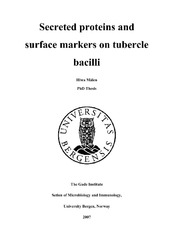Secreted proteins and surface markers on tubercle bacilli
Doctoral thesis
Permanent lenke
https://hdl.handle.net/1956/2639Utgivelsesdato
2007-12-12Metadata
Vis full innførselSamlinger
Sammendrag
Tuberculosis caused by Mycobacterium tuberculosis (M. tuberculosis) is the major cause of mortality and morbidity of over two million people each year. Mapping of proteins exported by the pathogen to the extracellular environment is necessary to understand the biology of the pathogen and for identification of novel drug targets and vaccine candidates to eliminate the disease. On this background we investigated the secreted sub-proteome and membrane subproteome of M. tuberculosis and M. bovis in this study. The secreted proteome of M. tuberculosis H37Rv culture filtrate made by Sadamu Nagai, was analysed using two different protein separation methods combined with MALDI-TOF and LC-MS/MS. We showed that this culture filtrate was particularly enriched in terms of secreted proteins compared to what has been reported previously. Furthermore, we searched with the generated mass spectra against a novel database including all predicted secreted proteins by the SignalP algorithms, after the removal of their predicted signal peptides, leading to the identification of the N-terminal peptides of over 40 proteins, confirming the bioinformatic prediction of the presence of a cleavable signal peptide in these proteins, with the AXA motif directly up-stream to the cleavage site as the most common recognized motif for signal peptidase I. Further, due to the significance of proteins exported to the surface of the bacterium and their involvement in the pathogen-host interaction, the membrane and membrane-associated proteins were extracted using Triton X-114 phase separation from whole sonicated M. bovis BCG bacilli, a close relative to M. tuberculosis. Proteins from the lipid phase were precipitated by ethanol. To reduce the complexicity of the extracted protein mixture, two different separation strategies were used; both at protein and peptide level, combined with subsequent identification using LC-tandem mass spectrometry. As a result, over 100 membrane and membrane-associated proteins were identified including around 50% all predicted lipoproteins in the genome. The culture filtrate protein mixture of M. tuberculosis used in our first work investigated to identify novel antigens. For this purpose, two different approaches were used to separate the proteins according to their hydrophobicity and pH followed by molecular mass based separation. A total of 20 serological reactive proteins were identified, including 4 novel antigens. The immunogenicity of the identified antigens and their relative antibody quantities were measured using Image Master software. We show that antibodies against proteins belonging to the antigen 85 complex were the most abundant in the serum of M. tuberculosis infected patients, and that secreted lipoproteins were the most immunogenic proteins in term of high antibody to protein amount ratio were lipoprotein, illustrating the importance of this group of proteins for serodiagnostic development.
